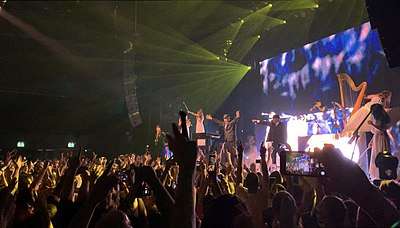Frenchcore
Frenchcore is a subgenre of hardcore techno. The style differs from other forms of hardcore in terms of a faster tempo, usually above 200 BPM, and a loud & distorted offbeat bassline.
| Frenchcore | |
|---|---|
| Stylistic origins | Early hardcore, mainstream hardcore, happy hardcore, hardstyle |
| Cultural origins | Early 1990s, France, The Netherlands |
| Typical instruments | Digital audio workstation, Keyboard, synthesizer, drum machine, sequencer, sampler, |
| Subgenres | |
| Euphoric Frenchcore | |
| Regional scenes | |
| Netherlands, Germany, France, Austria, Switzerland, Italy, Spain | |
| Other topics | |
| Hardcore | |
In the 1990s, drum machines and samplers were used to make this style. As technology developed, DAWs such as Ableton and Cubase became the standard for production. Modern frenchcore is often performed with live musical performers and sampling alongside a DJ set.
History
Frenchcore is a product of the rave and freetekno scenes in France dating back to the early 1990s. The first frenchcore act, Micropoint, was founded by DJ Radium and Al Core in 1992. In 1994, DJ Radium focused on his solo career and became known as the most significant contributor to the genre in the 90s. [1] He founded Psychik Genocide, one of the first frenchcore labels. Radium eventually became a touring artist and performed across Europe and in the United States. [2] The genre remained underground for many years, being based mostly in France & Italy.
The 2010s saw the reinvention of frenchcore, the rise of new artists, and a heavy Dutch influence as the genre became increasingly more popular in the Netherlands. In 2011, the first edition of "Frenchcore S'il Vous Plait" took place in Culemborg; 2012's edition of Thunderdome, the world's biggest hardcore festival, had an area dedicated exclusively to frenchcore. In 2014, Defqon.1, the world's largest hardstyle festival, added a frenchcore stage for the first time.

The releases on Peacock Records took a different direction from the music DJ Radium and The Sickest Squad were releasing, which created a shift in the genre to a more melodic, psychadelic, and modern sound created by younger producers. In 2016, modern frenchcore's popularity expanded beyond Europe for the first time when Dr. Peacock toured through the United States with performances in New York City, Denver, Phoenix and Pittsburgh. Dr. Peacock also performed in Sydney, Australia that same year. [3]
In 2016, several members of Peacock Records started taking more inspiration from hardstyle artists and calling their genre "Euphoric frenchcore". With the new melodic influence in the genre, the style began to appeal to listeners of hardstyle. Many frenchcore artists began experimenting with the integration of live instruments in their performances, as opposed to performances only using DJ equipment. The genre's popularity grew rapidly when Dr. Peacock's 17 year old protégé Sefa released his first album "Leven is Lijden" in 2018. The album introduced many hardstyle fans to frenchcore, and Sefa began to perform at major hardstyle festivals regularly.[4]In 2018, Dr. Peacock closed out Qlimax, Q-dance's yearly indoor event at the Gelredome, with the first ever frenchcore set at the show. [5]
Style & Performance

Frenchcore is characterized first and foremost by its fast tempo and offbeat distorted bassline. Frenchcore, like most forms of electronic dance music, was initially only produced in 4/4 time. The style has recently developed to include different time signatures such as 3/4 and 5/8 and more advanced compositions influenced by classical music. [4] [6] Since the mid 2010s, tracks became more harmonic through the use of pitched kick & bass, just like hardstyle or mainstream hardcore. A frenchcore track typically either has a melody accompanied with the kick & bass harmonically, or the kick & bass on its own in a rhythm focused form.
Tempo wise, frenchcore is usually performed around at around 200 beats per minute with variation. Since frenchcore tracks are produced at different tempos and performers have to account for their timeslots and different types of events, the tempos within a frenchcore set can vary from 180 BPM all the way to 220 or more, with artists sometimes ending their performances with terror or speedcore. Since uptempo hardcore lies in a similar BPM range, frenchcore artists often mix in uptempo tracks into their sets. Artists from both genres often perform on stage side by side together mixing both genres in one set. [7]
Initially, frenchcore was performed was performed by a DJ or a sound system (see free tekno) playing vinyl records. Modern frenchcore performances are now much more commercial and performed on standard DJ equipment and sometimes feature extra instruments to add a live element to the show.
Notes
- "LE DJ DE TECHNO HARDCORE RADIUM NOUS PARLE DE SA PASSION ET DE SON AVIS SUR LA MUSIQUE ÉLECTRONIQUE !| Ravefeed". www.ravefeed.com. Retrieved 2020-03-18.
- "Interview with RADIUM". Scottish Hardcore. Retrieved 2020-04-22.
- "DR. PEACOCK: INTERVIEW FROM TRAUMA| The Hard Data". Retrieved 2020-03-18.
- Mandel, Alan. "Life is Suffering & Sefa is Going To The Top". EDM.com - The Latest Electronic Dance Music News, Reviews & Artists. Retrieved 2020-03-18.
- "Dr.Peacock Interview Qlimax 2018 | Q-dance". www.q-dance.com. Retrieved 2020-03-18.
- "Sefa - Combining a Love for Frenchcore & Classical Music | YouTube". youtube.com. Retrieved 2020-03-18.
- "BKJN VS. PARTYRAISER REVIEW (20 JANUARY 2018) | YouTube". theharddata.com. Retrieved 2020-03-23.